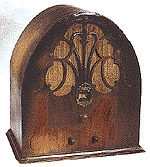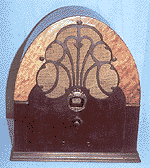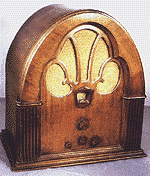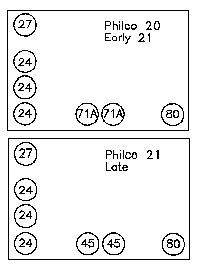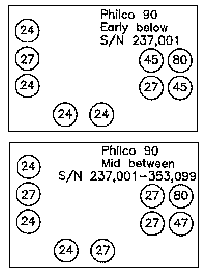|
|
• EARLY CATHEDRAL IDENTIFICATION • | |||||||||||||||||||||||||||||||||||||||||||||||||||||||||||||||||||||||||||||||||||||||||||||||||
| MODELS 20, 21, 70 and 90 FROM 1931-1933 |
||||||||||||||||||||||||||||||||||||||||||||||||||||||||||||||||||||||||||||||||||||||||||||||||||
BASIC IDENTIFYING METHODSExcerpted from articles which appeared in the August, 1993, July, 1994, May, 1995and July, 1995 issues with permission of Antique Radio Classified and the authors. © Copyright 1993, 1994, 1995 ARC, Ron Boucher and Ron Ramirez.
Serial Numbers
and Dates The serial number can help date your radio. The equipment that Philco used for stamping serial numbers was capable of stamping six digits. This meant Philco could go up to 999,999 using only digits, but in the 1931 model year, higher serial numbers were required. What the company did was to use the letter "A" instead of "10" for the first digit, and "B" instead of "11". The next number after 999,999 was A00000, which corresponded to (10)00000 (another example: B22000 = 1122000).
Since many of the cabinets have dates rubber-stamped on the bottom of
the cabinet, we have a chance of correlating the date, serial number, and features to find out when these changes occurred.
The survey results, as of July, 1995, are shown in the accompanying graphs and charts. The charts will allow you to pinpoint when a particular radio was made from the serial number or other features, even if that radio had no date stamp.
Knowing that the cabinets were not made in the same area of the factory as the chassis, we realize that the serial numbers on the chassis and the date stamps on the cabinets might not correlate one hundred percent, but we think sufficient responses to this survey should help make sense of the numbers. It is important to note if you have any doubts that the chassis came originally with the cabinet.
If you would like to include the data from early Philco sets you may have in your collection, use the authors' Survey
Form. Explainations for the survey questions are belown to help you with your answers.
Data Guide Explanation Since there are many variations in the models being surveyed, even experienced
collectors sometimes have difficulty making proper identification. The Data Guide in Table 1 below, is intended to aid those who may have only one set and no others with which to compare it. They can now identify their models more easily and provide the information we request.
Model This
column lists the models included in the survey. Note that Model 21 has an "early", "late", and "very late" version with chassis variations.
Serial Number Please enter the serial number for each of your radios.
Cabinet Type / Decal Please indicate which cabinet style your set has (see Figs. 1 - 4 above). For Model 20, also indicate whether the cabinet is "plain" or "deluxe". Also please note any cabinet variations in the other models and indicate if your radio has a patent design decal on the rear arch of the cabinet (see Fig. 6).
Knobs This column
identifies two different knob styles commonly referred to as "plain" or "rosette", as shown here in Figure 5. Please indicate if the knob style listed does not agree with the knobs on your set(s).
AVC Model 70 sets without Type 35 tubes do not have AVC (Automatic Volume Control). For Model 90, if the set has the "Normal-Maximum" toggle switch on the back of the chassis, it does not have AVC.
Date of Manufacture Look for a date stamp, usually rubber-stamped on the bottom of the cabinet, and enter the date in this column. Note: Models 70 and 90 show different manufacturing periods for the same model number, so be sure to check the date of manufacture of your set against the data given.
Switch Some
Model 90 sets have a "Normal-Maximum" switch on the rear of the chassis and some do not. Check your set for the presence of this switch.
Escutcheon If you
have a Model 70, does it have a metal or Bakelite escutcheon? The escutcheon is the ornamental plate surrounding the tuning
dial scale.
Tubes The number
of tubes and tube types is very important. Carefully check the tube compliment of your set against the tube compliments shown in the these diagrams. Be sure also to check Table 1 for the tube types and quantity for the model chassis in your radio. Note: Your set may have other substitute (or wrong types) tube types installed from a previous repair job!
Trimmers If you
have a Model 20, note that a chassis can have 1, 2, or 3 trimmer condensers. These trimmers" are screw-type adjustments are usually mounted on the variable tuning capacitors. Please indicate whether your set has 1, 2, or 3 trimmers.
Comments A remarks line is provided at the bottom of the form. Please add any comments that may be helpful.
|
||||||||||||||||||||||||||||||||||||||||||||||||||||||||||||||||||||||||||||||||||||||||||||||||||

